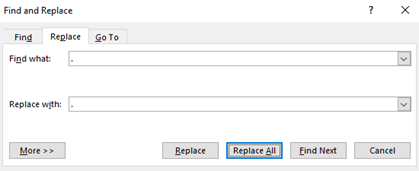Punctuation
Guidance for bulleted lists, commas, colons, hyphens, spaces, and more.
Bulleted lists
Capitalization
Capitalize the first letter following a bullet, even if it follows an introductory phrase. All proper nouns should be capitalized appropriately no matter their place in a bulleted list.
Punctuation
Use a period after every bulleted complete sentence or if the bullet completes an opening statement. Do not use periods for sentence fragments or lists. Do not use semicolons, commas, or conjunctions to end a bulleted list. Periods are the only punctuation to be used with a bulleted list. Avoiding switching between complete and incomplete sentences within the same bulleted list.
See the example below for correct usage of capitalization and punctuation in a bulleted list.
- Register with SAM.gov.
- Obtain a Federal Communications Commission Registration Number (FRN).
- Submit an application for FCC approval to participate in the program.
- Obtain FCC approval to use an alternative eligibility verification process.
- Submit an ACP election notice to USAC.
Commas
Use the serial comma (sometimes called the Oxford comma). In a list of three or more, include a comma before the conjunction. For example: *Please include your address, phone number, and email*.
Colons
Capitalize the first word after a colon only if it is a proper noun or the start of a complete sentence. In headlines, capitalize any word after a colon. See the examples below for correct capitalization after a colon.
- There were three considerations: expense, time, and feasibility.
- Only one person knew how to use the computer: Bethany.
- Please note: The office will remain closed until further notice.
- Full Immersion: An Introduction to Immersive Theater.
Em and en Dashes
When offsetting a phrase with dashes you should use the longer em dash (—) with a space on either side of the dash. For example: We emphasize open data, and — whenever possible — we illuminate our processes.
Although we advocate using words rather than symbols, in some contexts you may use an “en dash” to convey a range of numbers. For example, both *10–20 students* and *10 to 20 students* are acceptable.
Spaces
When writing for USAC, always separate sentences by a single space, never two spaces.
Be aware that the FCC and other federal agencies often place an extra space between sentences, a practice that was used when writing with typewriters. When copying their content and pasting it into a USAC document, remember to search the content for double spaces using the Find and Replace function in Word.
Hit keys Ctrl+F to open the Navigation side panel. Click on the downward arrow in the search box and select ‘Replace’ from the drop-down list to open a new dialog box.

Enter a period follow by two spaces (“. “) in the ‘Find what’ box, and a period followed by a single space (“. “) in the ‘Replace with’ box. Then click the “Replace All” button.

Ampersands or plus signs
Use "and" instead of an ampersand or plus sign, unless they're part of an official title or company name. For example, *Cotton & Company* or the *Schools & Libraries Committee*. *Note: The only time you write "Schools & Libraries" is when referring to the Schools & Libraries Committee, in which case you always do.*
Hyphens
Use a hyphen to join words serving together as a single adjective before a noun:
- chocolate-covered peanuts
- well-known author
Compound modifiers after a noun are not hyphenated:
- The peanuts were chocolate covered.
- The author was well known.
Use a hyphen with compound numbers and with inclusive numbers:
- forty-six
- The 2022-23 funding year began August 31.
Use a hyphen to avoid confusion or awkward letter combinations:
- re-sign a petition (vs. resign from a job)
- semi-independent
Quotation marks
For direct quotations, surround the exact words of a speaker. For example: *“Closing the digital divide is a priority,”* he said, *“the FCC has made great strides.”* Quotation marks are not required in formats that clearly identify content in question and answer format or interview format (i.e. Q and A).
A word or words being introduced to readers for the first time may be placed in quotation marks on first reference. For example, *Applicants often apply for “lit fiber” funding*.
Exclamation points
Avoid using exclamation points. They increase informality and are not in-line with USAC’s tone.
